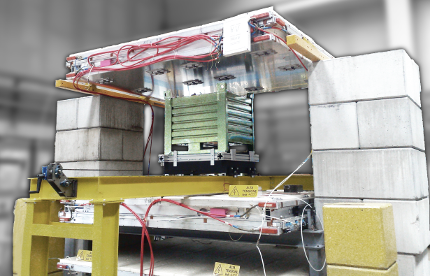MonteCarlo Simulation
We have real data that we can acquire in the prototype environment. To enlarge the horizon of possible application we built a MonteCarlo Simulation Environment. The LNL prototype has been accurately described. Therefore we throrouly tested the reliability of our SE against the real data to ensure the reliability of its results. Through the simulation, we can now explore the capability of the technique under different situations to test its capabilities for several applications.
Particles behavior and mechanical setup is simulated using the GEANT4 particle simulation tool, developed at CERN for particle physics experiments.
Shielded Radioactive Sources Detection
Under the Mu-Steel European Project, we used the simulated environment to move from the modest-scale scanning volume of the prototype to a full-scale portal. Its size makes it capable to host an entire truck container. We tested the efficiency of the technique, and our software, in indentifying the presence of a shielded radioactive source hidden inside a container filled with scrap metal. The idea is to offer a device to scan trucks headed to melting facility that may hide an orphan source inside the shipped scrap metal. The results show that the system is able to offer a great contribution to protect the environment, and human health, from the menace of the accidental melting of a radioactive source.
The portal, truck, sources and scrap metal have been designed though a GDML implementation and the MonteCarlo data reconstructed in 3D images using our software.
We studied and built a prototype chamber for a next-generation scanning portal. This chamber is based on drift tubes detectors technology (unlike the CMS chambers used in the prototype), that allows to drastically reduce the cost of building a larger portal. Moreover, the drift tubes grant a better durability under harsh condition that may arise in an industrial environment.
 Tomographic scanner built at LNL, Padua
Tomographic scanner built at LNL, Padua The MonteCarlo Simulation of the Prototype
The MonteCarlo Simulation of the Prototype